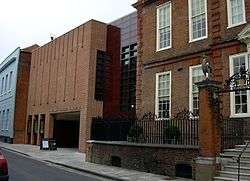Pallant House Gallery
|
The gallery extension, with Pallant House on the right. | |
 Location of Pallant House Gallery | |
| Established | 1982 |
|---|---|
| Location | North Pallant, Chichester, West Sussex |
| Coordinates | 50°50′06″N 0°46′40″W / 50.835109°N 0.777800°W |
| Type | Art Gallery |
Pallant House Gallery is an art gallery in Chichester, West Sussex, England. It houses one of the best collections of 20th century British art in the world.[1][2]
The Gallery's collection is founded on works left to the city of Chichester by Walter Hussey in 1977, which included works by Barbara Hepworth, Henry Moore, John Piper, Ceri Richards and Graham Sutherland. Hussey stipulated that the collection must be shown in Pallant House.
In 1989, Charles Kearley donated works by British artists such as John Piper and Ben Nicholson and European artists such as Paul Cézanne, André Derain, Fernand Léger, and Gino Severini.
In 2006, Colin St John Wilson donated works by Michael Andrews, Peter Blake, David Bomberg, Patrick Caulfield, Lucian Freud, Richard Hamilton, R. B. Kitaj, Eduardo Paolozzi, Walter Sickert and Victor Willing.
The Gallery also has a collection of 18th century Bow porcelain, donated by Geoffrey Freeman.
The collection
The Gallery's collection is founded on works left to the city of Chichester by Walter Hussey in 1977, on his retirement from the position as Dean of Chichester Cathedral which he held from 1955. Hussey's collection included works by Barbara Hepworth, Henry Moore, John Piper, Ceri Richards and Graham Sutherland. Hussey stipulated that the collection must be shown in Pallant House.
The Gallery's collection has been augmented by other donations. In 1989, property developer Charles Kearley donated works by British artists such as John Piper and Ben Nicholson and European artists such as Paul Cézanne, André Derain, Fernand Léger, and Gino Severini. In 2006, architect Sir Colin St John Wilson donated works by Michael Andrews, Peter Blake, David Bomberg, Patrick Caulfield, Lucian Freud, Richard Hamilton, R. B. Kitaj, Eduardo Paolozzi, Walter Sickert and Victor Willing. Many of the works were acquired directly from the artists, who were friends of Wilson: indeed, he designed homes for several. Other works are displayed on long-term loan, many on the understanding that they will be donated to the gallery in due course. As well as modern British art, the Gallery has one of the world's outstanding collections of 18th century Bow porcelain, donated by Geoffrey Freeman.
Exhibitions
From October 2015 to February 2016 the Gallery mounted an exhibition, Evelyn Dunbar: The Lost Works; 500 paintings by Evelyn Dunbar that had disappeared after her death in 1960 and rediscovered in 2013, doubling the number of her known works.[3][4]
In 2016, the Gallery mounted an exhibition entitled John Piper: The Fabric of Modernism of Piper's textile designs.[5]
Pallant House
Pallant House is a Grade 1 listed Queen Anne townhouse built in 1712 for wine merchant Henry "Lisbon" Peckham and his wife Elizabeth. It is a fine, brick-built building with large windows, with stone ostriches from the Peckham family arms guarding the entrance gateway, and a fine oak staircase inside. Its urbane design from a London architect was the subject of a suit in Chancery, for William Smart, mason of Chichester, provided a design about 1711, but the Peckhams went to London and obtained another design, designated "the London modell" in court papers. The architect was not identified.[6]
The building had been used as Council offices since 1919. The building was restored in 1979, and the gallery opened in 1982. It has been managed by an independent trust since 1985.
A new wing was opened in June 2006, designed by Sir Colin Wilson and Long & Kentish. The £8.6 million project was funded by the Heritage Lottery Fund, Arts Council England, the local council, and other donors. The unashamedly modern block, which stands next to and integrates with the original Queen Anne building, won the 2007 Gulbenkian Prize;[7] in the words of the judges, the juxtaposition creates "a vibrant relationship between old and new ... continued in a series of inspired contemporary installations" which are housed within.[8] The extension was also listed for a 2007 RIBA award.
It is believed to be the first art gallery in the UK which is heated and cooled by a geothermal system, using water pumped through 69 pipes descending 35 metres under the building, connected to reversible heat pumps, which roughly halves its carbon emissions.
To the rear is a new courtyard garden, designed by Christopher Bradley-Hole, a Chelsea Flower Show gold medallist.
Notes
- ↑ Gulbenkian Prize 2007 longlist - Pallant House Gallery, from 24 Hour Museum
- ↑ Profile of the Pallant House Gallery from the Saatchi Gallery.
- ↑ The Observer newspaper: Evelyn Dunbar: the genius in the attic, 18 October 2015
- ↑ Pallant house Gallery Web site: Evelyn Dunbar: The Lost Works, exhibition 3 October 2015 – 14 February 2016, retrieved 19 October 2015
- ↑ "John Piper: the Fabric of Modernism". Pallant House Gallery. 2016. Retrieved 9 May 2016.
- ↑ Howard Colvin, A Biographical Dictionary of British Architects, 1600-1840 3rd ed. 1995: sub "Henry Smart", quoting Sibylla J. Flower, in Pallant House (Chichester 1993) pp 32-34.
- ↑ Gallery wins 'biggest' arts award, BBC News, 24 May 2007.
- ↑ Pallant House Gallery wins £100,000 Gulbenkian Prize, press release, 25 May 2007.
External links
| Wikimedia Commons has media related to Pallant House Gallery. |
